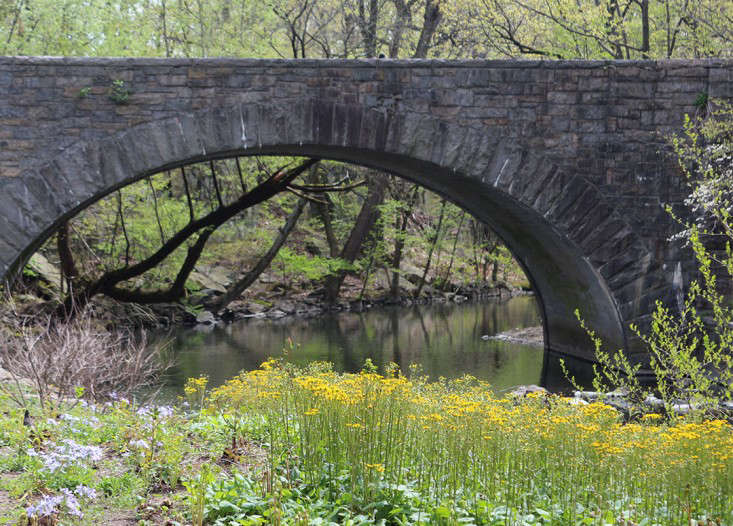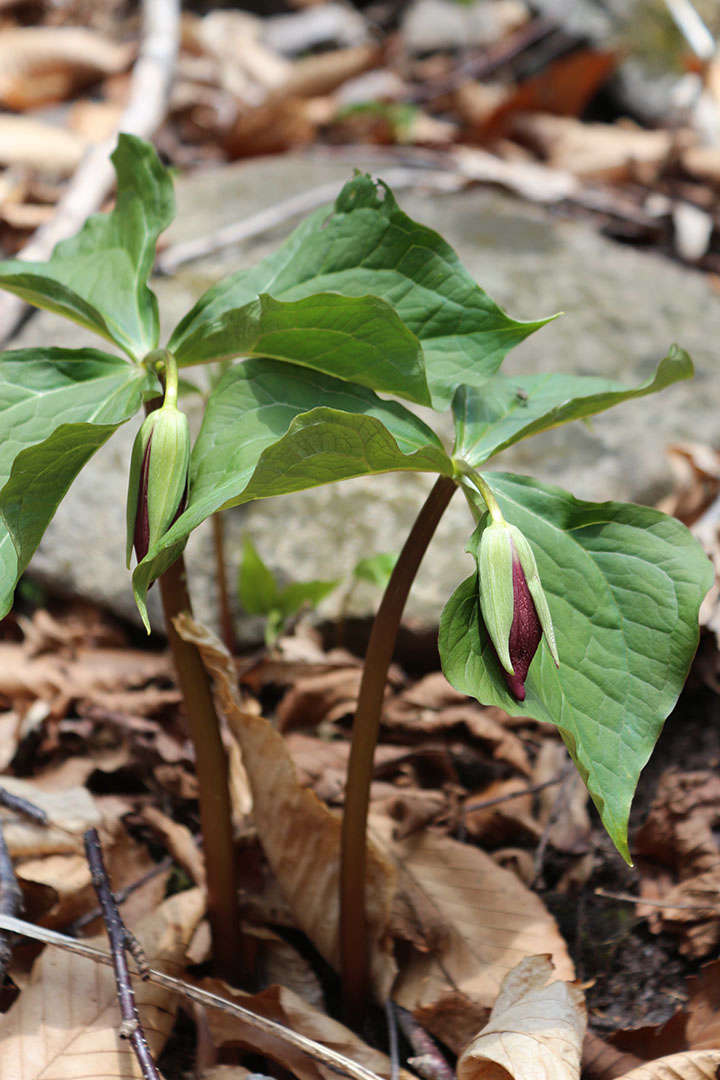A walk in local woods, mountains, or native-conscious park can be inspirational for a gardener who has been dealt a shady hand. Indigenous American plants perform well in gardens and are increasingly available at nurseries. Adapted to the dappled conditions of woodlands, these perennials will thrive in well-drained, humus-rich soil (think compost) in your garden.
Here are nine flowering perennials that offer an appealing palette of texture and bloom for cold climate gardens where shade sets the pace.
Photography by Marie Viljoen.
Fringed Bleeding Heart
Above: A Fringed Bleeding Heart is $12 from Monticello Catalog.
Dicentra eximia is native to the eastern United States and has an unusually long bloom time for any perennial: its pendant dusky pink flowers open steadily from mid-spring through summer, unlike the larger Asian bleeding heart (Lamprocapnos spectabilis) which disappears after spring. Fringed bleeding heart makes an attractive mound of feathery blue-green leaves and self -seeds when it is happy, so expect more plants than you started with. It is hardy from USDA Plant Hardiness Zones 3-9.
Trout Lily
Above: Erythronium americanum has many common names (often a sign of a loved and useful plant): trout or fawn lily (because of the spotted leaves), adder’s tongue (the buds are sharply pointed), and dog-tooth violet (because of the snaggle-toothed corms underground). These ephemerals are one of the jewels of shady forest floors in the eastern United States. Happiest in slightly acidic soil they will bloom in mid-spring and become dormant in summer, disappearing entirely. Plant them with companions whose flowers or foliage will fill out in late spring. Trout lilies are hardy from Zones 3-8.
Golden Ragwort
Above: Packera aurea sparkles with life in shade and will grow in some sun, too. The yellow daisy-like flowers appear for about four weeks in spring. The fine-toothed, rounded leaves provide a good groundcover for the rest of the season as long as the soil does not dry out. Golden ragwort is hardy from Zones 3-8.
Wake Robin
Above: Trillium species are the woodland aristocrats of the Midwest and eastern United States. In late spring their graceful flowers are distinctive and elegant. Trilliums resent full sun and their rhizomes are best planted in bright shade under high, deciduous trees or in an area with morning sun and afternoon shade. Humus-rich soil is essential, as is good drainage. Trilliums are hardy from Zones 4-8.
May Apple (American Mandrake)
Above: A bare root May Apple is $7.49 from Prairie Nursery.
Podophyllum peltatum is an unusual eastern native, emerging in early spring like a reptile from a sticky egg sack. In May mature plants carry one waxily perfect, anemone-like flower per forked stalk. The umbrella-like leaves obscure the flowers, so that you must bend down to see these May-blooming secrets. En masse, May apples make a luxurious groundcover through summer, when they become dormant and flop over. The egg-shaped fruits ripen on the ground where they are often eaten by wildlife. The pale yellow fruits are sweet and tropically aromatic and must be eaten only when ripe (the leaves and roots of the plant are poisonous). They make exquisite jelly. May apples are hardy from Zones 4-8.
Doll’s Eyes
Above: One of the best wild perfumes belongs to the woodland native Actaea pachypoda. The scent of the fluffy white flowers is like lemon blossom, and becomes more conspicuous towards evening. The common name refers to the Halloween-creepy appearance of the late-summer berries: white, each with a black tip for a pupil, and attached to bloodily red stems. The berries are very poisonous (another common name is baneberry). This is not a perennial for a garden where small children play unsupervised. Doll’s eyes are hardy from Zones 3-8.
Solomon’s Seal
Above: One of the best known shade plants, the variegated form of Polygonatum odoratum is a cousin of our native and all-green Polygonatum biflorum—a couple of the toughest and most graceful perennials, growing well in sun as well as dense shade. The tall, arched stems drip with sweet little green-and-white bell flowers in mid-spring, forming dense colonies over time. And if you have a large enough patch you can enjoy the juicy rhizomes as a crunchy snack. Hardy from Zones 3-8.
False Solomon’s Seal
Above: The bowed stalks of Maianthemum racemosum resemble Solomon’s seal, until they begin to bloom, showing off feathery white plumes at their tips. By fall these flowers have turned into ornamental clumps of red berries. Growing in eastern woodlands, False Solomon’s seal is hardy from Zones 4-9.
Virginia Bluebells
Above: A Virginia Bluebell is $12.95 from White Flower Farm.
With flowers of heartbreaking blue, Mertensia virginica is the native answer to dreams of European bluebell woods, perfectly suited to being massed under deciduous trees, to receive early spring sunshine. The leaves emerge intriguingly purple, before unfurling (Virginia bluebell leaves are edible, and a good addition to salad). Plant them with companiona such as native lady ferns, or exotic hardy begonias, which will fill in as the native bluebells go dormant in summer. Virginia bluebells are hardy from Zones 3-8.
Contact your local nurseries to see which native wildflowers they stock, and ask for local recommendations.
For more of Marie’s picks, see 8 Flowering Shrubs and Small Trees for Cold Climates and 8 South African Flowers for American Gardens.
Finally, get more ideas on how to plant, grow, and care for various perennial plants with our Perennials: A Field Guide.
























Have a Question or Comment About This Post?
Join the conversation (3)